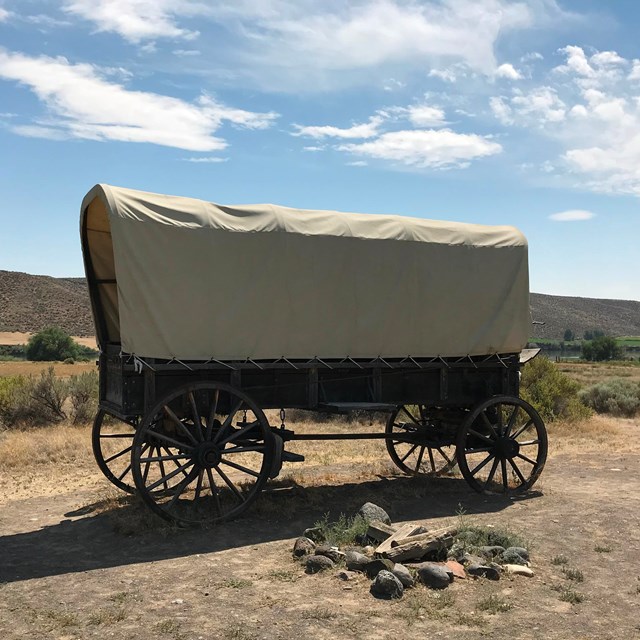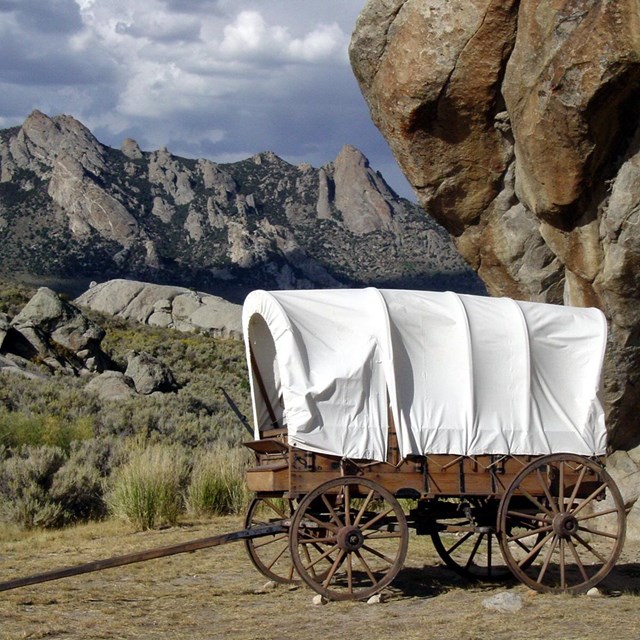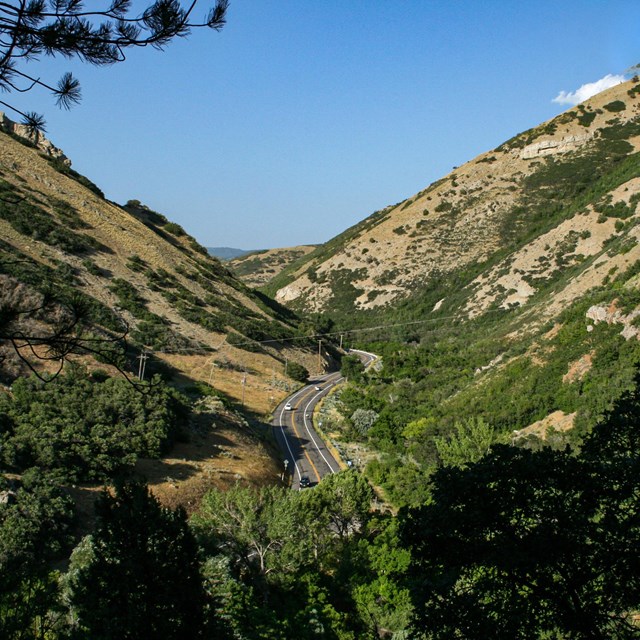Part of a series of articles titled The Emigrant Experience .
Article
The Platte Experience
Otoe Indians called this region “Nebrathka,” meaning “flat water,” and the French word “Platte” means the same. The defining flatness of the broad Platte River Valley, which averages five to seven miles wide, made it ideal for animal-powered travel on both sides of the stream. Besides being “good wheeling,” the long Platte River stretch of trail also provided plenty of water and native grasses for game and livestock. Many emigrants later recalled it as the easiest, most pleasant part of their westering journey.
…As prity a rode as I ever saw….it is level and smooth as a plank floor. —Dr. A. H. Thomasson, emigration of 1850
We traveled through the most level plains I ever saw in my life. Here is such a scenery of beauty as is seldom witnessed. —Joseph Williams, circa 1842
The sight of a tree is out of the question. It is seldom we see so mutch as a bush.—Levi Jackman, Mormon emigration of 1847
North or south of the Platte, travelers shared similar experiences. Some were delighted by the open, treeless expanse while others were dismayed by it. Many wrote of the flowers, animals, sand hills, and rock formations they encountered along the trail. Nearly everyone complained about the dirty water, the quicksand, and the swarming, biting insects. Most were thrilled by their first sighting of bison and their first taste of buffalo steak, but not so happy about having to collect and cook over “buffalo chips” due to the scarcity of firewood.
Bison, or American buffalo, had been hunted out of their range in the eastern United States by the early 1800s. In the first decades of the emigration, Easterners saw their first buffalo along the Platte in vast numbers, herds of thousands and tens of thousands that covered the plains like a brown, woolly blanket. The massive herds sometimes blocked wagon trains for miles, and occasionally charged through a wagon train or trail side camp, frightening livestock and wrecking wagons. Professional buffalo hunters slaughtered bison to sell their hides for industrial uses, soldiers killed them to provision their forts, 15 Auto Tour Route Interpretive Guide Nebraska and emigrants shot them for food as well as sport. By the early 1860s, travelers saw few buffalo in the Platte River Valley.
Plains wildlife, natural beauty, and minor complaints aside, trudging in the choking dust with ox-team and wagon under the hot Nebraska sun was no picnic. Many noted in their journals the furious storms that raged over the plains, stampeding livestock and terrifying travelers —even killing some. People died from accidental gunshot, slipping under wagon wheels, injuries caused by unruly oxen, drowning during a stream crossing, and from complications of pregnancy and childbirth. Cholera took many lives, leaving single parents to carry on alone, hundreds of miles from home, with a wagonload of youngsters —or worse, leaving frightened orphans to depend on the kindness of strangers. Many of the dead were buried in unmarked graves on the wagon trail itself, in hopes that neither wolves or Indians would rob their final resting place.
The [buffalo] dung was thick in most places, and like chips and score blocks —for this and the sake of softening a hard word they go by the name of Buffalo chips. —Oliver Boardman Huntington, Mormon emigration of 1847
There came up a storm in the afternoon. The wind blew very hard and on the opposite side of the river a tremendous hurricane. We saw trees flying on the air and water blown out of the River as high apparently as the clouds. —James John, emigration of 1841 . . . instead of a single fork or chain [of lightning] a dozen would burst from the dark mass & rush in every direction like serpents from a rocket….at times the whole heavens would appear to be as a blaze for several seconds during which time the minutest object could be discovered. —William Henry Tappan, civilian draftsman at Fort Childs (Fort Kearny), June 1848
The team behind us stop[ped] in mid-stream…and the treacherous sand gave way under their feet. They sank slowly, gradually, but surely. They went out of sight inch by inch, as the water rose over the moaning beasts. Without a struggle they disappeared beneath the surface. In a little while the broad South Platte swept on its way, sunny, sparkling, placid, without a ripple to mark where a lonely man parted with all his fortune. —Luzena Stanley Wilson, emigration of 1849
Indians were a huge worry for many travelers, though for the most part emigrant encounters with Native Americans on the trails across Nebraska were peaceful, even enjoyable. In the early years of the emigration, in particular, native people viewed the “Great Medicine Road” as a kind of grand market where they could trade for goods and visit with travelers. Emigrants and Indians, including the much feared Pawnees, exchanged many acts of personal kindness; and the Sioux, who controlled most of the Platte River Valley, allowed the wagons to pass in peace.
Still, most emigrants entered Indian Country expecting the worst. Their fears of Indian attack were fueled by rumors, hoaxes, and lurid half-truths in newspapers and popular books —but also by a long history of very real, very violent Indian and settler conflicts in the East. Rumor, history, and experience likewise gave native Plains people reason to be wary of white Americans. When the first great flood of humanity and beasts rushed up the Platte Valley in 1849, stripping the countryside of grass and driving off the buffalo and other wild game, that wariness began to turn to resentment.
Last updated: January 26, 2021



